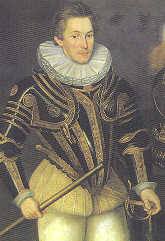

Prince Maurice of Orange
| Maurice of Nassau, by Daniël
van den Queborne, 1585-1590, Oil on canvasMaurce
of Nassau (1567-1625) is a striking portrait
of the man that … the war of the Republic against Spain. Maurice was the son of
William of Orange and Anna of Saksen. He studied at the university of Leiden and after the
death of his father in 1584 he followed him as ‘stadhouder’ (governor) of
Holland and Zeeland. Later he also became ‘stadhouder’ of Utrecht, Gelderland
and Overijssel and finally even of Groningen and Drenthe. He was considered one of the
most skilled army commanders of his time, and freed near enough all cities over which he
was ‘stadhouder’ from the Spaniards. Well known in Dutch history is the Battle
of Nieuwpoort (Belgium) in 1600. When he died in 1625 he was followed by his
brother Frederik Hendrik.
In the whole world not one original suit of armour of the princes of Orange is to be found any more, except for one of Maurits from about 1590 in the collection of the Jofjagd-und Rüstkammer des Kunsthistorischen Museums in Vienna, Inv. A 1654. Maurice gave his suit of armour of Dutch make to, of all people, the Roman Catholic archduke Ferdinand of Tyrol. The archduke was an avid collector of weaponry and armoury, that had originally belonged to all sorts of ‘princes and potentates’. In the year 1601 Jacob Schrenck von Notzing published the book ‘Armamentarium Heroicum’ about the collection of the archduke, which had been gathered by him over the years in the castle Ambras near Innsbruck. It is the first true catalogue of an arms collection ever to appear in print. The archduke dwelt in Ambras castle near Innsbruck in which over the years he had collected armour that had belonged to various well-known ‘princes and potentates’. Prince Maurits’ armour is recorded in the 1621 inventory of the castle as follows: ‘Prince Maurice of Nassau. A black field armour without shins’ (without shin-guards). Apparently, despite the Dutch enmity towards the Spanish king Phillip II, the protestant Maurits did not feel troubled about a personal friendship with the Roman Catholic church potentate of Austria, despite the Dutch enmity with the Spanish king Philip II. After 400 years the ‘replica’ is now standing at the Army museum at an exhibition about the struggle, the tactics and the weapons form the ‘Eighty Years War’. It may be that the schoolbooks praise Maurice too highly as a strategist. But the great achievement of the prince lies in the training of his armies, until every manoeuvre could be executed faultlessly as by one man, following the example of the Roman legions in the high days of the Roman Empire. |